Written by: TechFlow
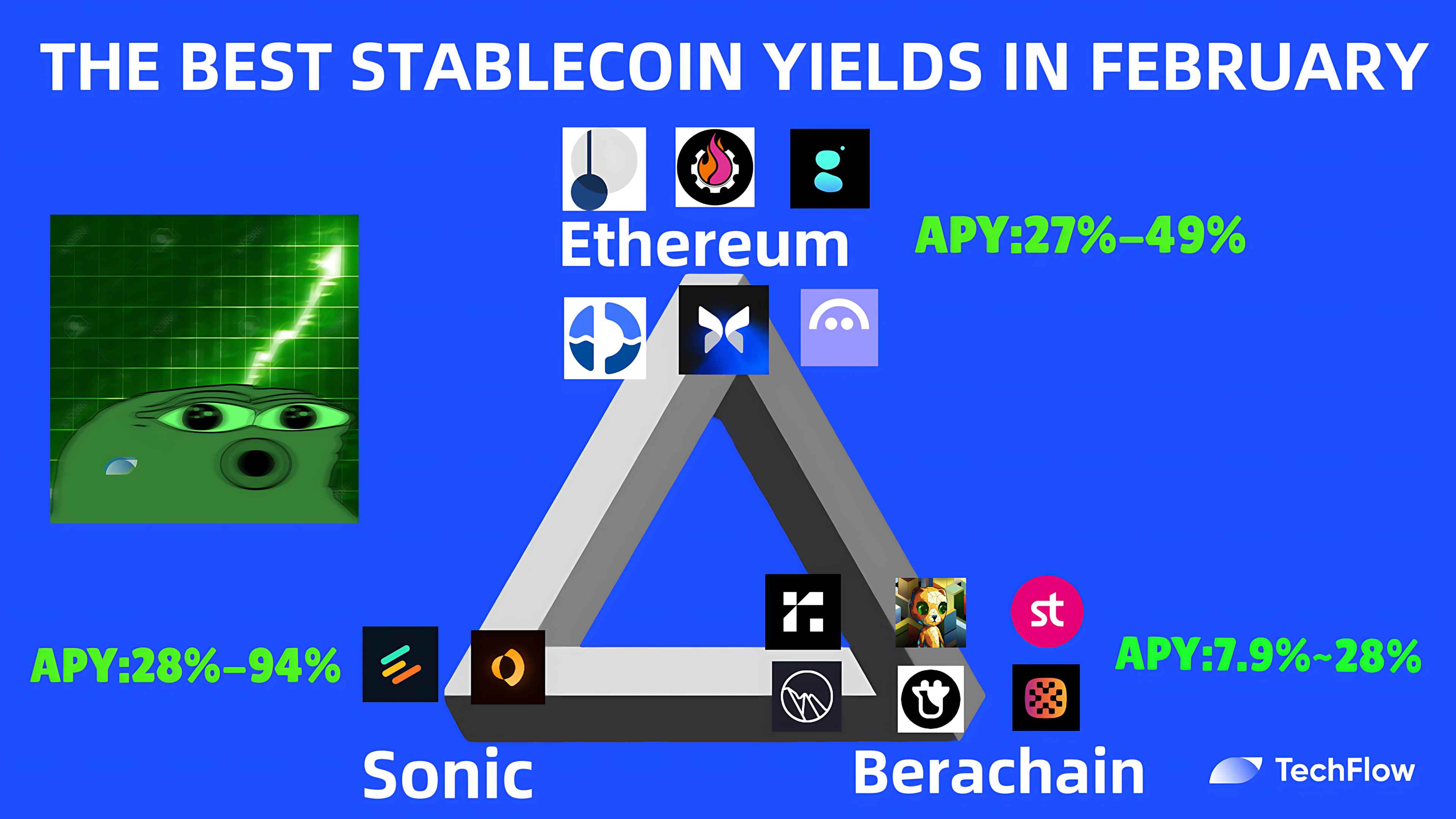
The recent market crash caught people off guard by the waterfall-like face wash.
The decline of Altcoin has made it difficult to find profits; and opening a contract with leverage may result in losing everything. Although everyone likes to watch Liang Xi's contract turnaround example, not everyone can do it.
But if we turn our attention to DeFi mining income (yield farming), our thinking becomes broader; especially some stablecoin financial management pools, which are relatively ideal choices for hedging against market decline risks.
Recently, well-known crypto analyst Stephen | DeFi Dojo ( @phtevenstrong ) also published a post detailing the current opportunities for on-chain stablecoin wealth management, covering Berachain, Sonic and mainstream protocols on Ethereum.
At this point, it is indeed worth shifting your attention to the stablecoin financial management market. The editor has actually experienced the products there and sorted out the essence of them, striving to provide everyone with a relatively stable income guide.
Stablecoin investment, you need to know where the high returns come from
"If you don't know where the profit is coming from, then you are the profit."
Stablecoins on different chains have their own characteristics due to differences in protocol design and ecology.
However, the sources of income for stablecoin financial management are similar. For example, through liquidity provision, lending (such as Aave, Compound) or leverage strategies (such as revolving mortgages), the income mainly comes from the transaction fees of the protocol, protocol rewards (such as governance token issuance) or borrowing interest rate differentials.
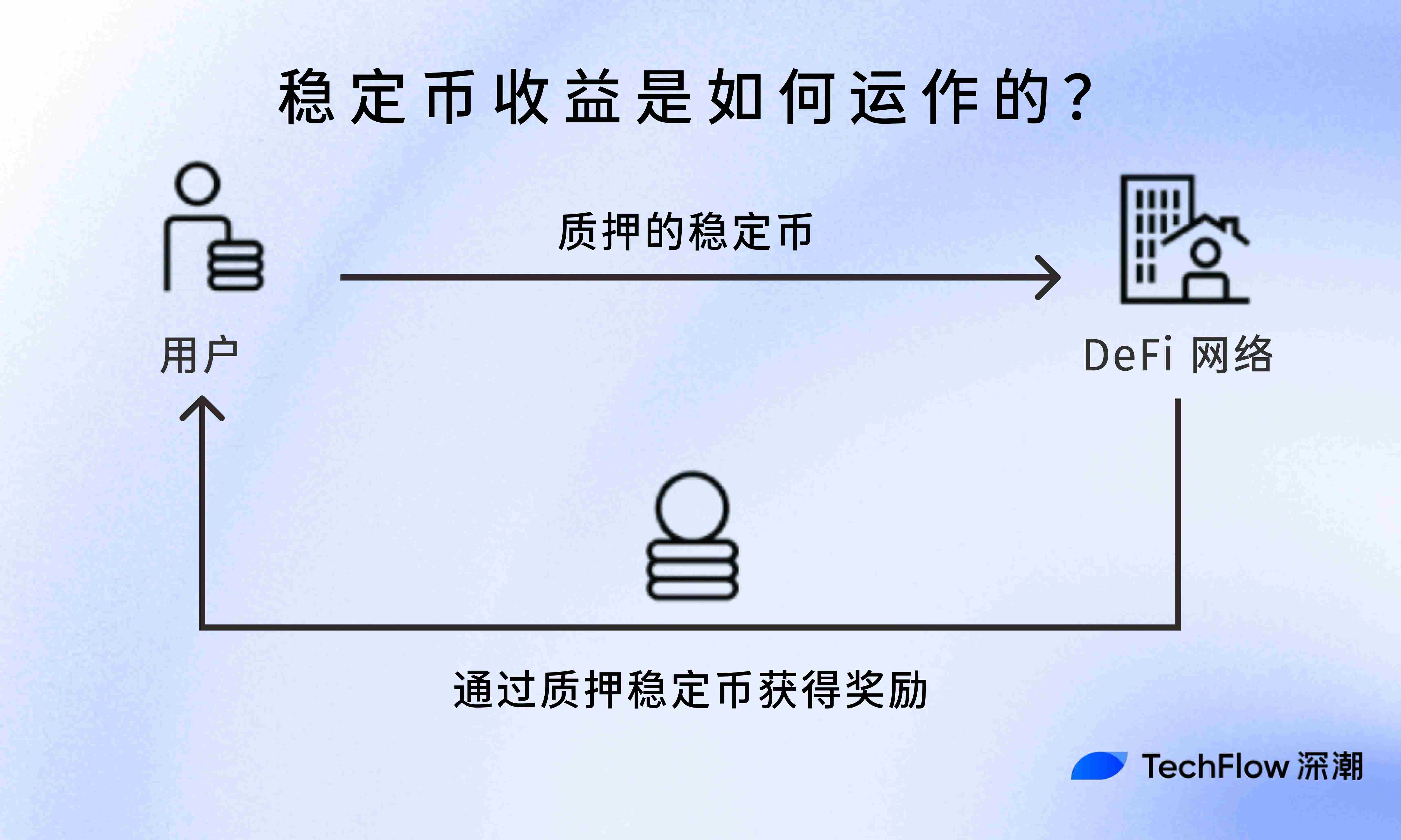
But why are the financial returns of stablecoins on some new chains surprisingly high?
1. High Token Incentives
In order to attract users and capital inflows, emerging chains usually incentivize users to participate in their ecosystems through high token rewards. These rewards usually exist in two forms:
Governance token rewards : Some chains distribute governance tokens (such as Berachain’s HONEY) to liquidity providers (LPs) to attract users to lock up assets.
Airdrop expectations : Some emerging chains have not yet issued tokens, and users will look forward to future airdrops, thus being willing to participate in high-risk profit pools.
This incentive mechanism is very common in the early stages of the chain because it can effectively increase liquidity and attract more users and developers to join the ecosystem.
2. Actually not that exciting
Protocols on emerging chains usually have less competition and a smaller user base, but their demand for liquidity and funds is high in the early stages of their ecosystem development. This imbalance between supply and demand can lead to the following phenomena:
Higher borrowing interest rates : Due to insufficient capital supply and strong demand for borrowing, the borrowing interest rates of stablecoins are pushed up, thereby indirectly increasing financial management returns.
High transaction fees : In decentralized exchanges (DEXs), insufficient liquidity can lead to higher slippage and fees, which liquidity providers can profit from.
3. Protocol design and leverage strategy
Protocols on emerging chains usually design some unique mechanisms or high leverage strategies to attract user participation. For example:
Looping Strategies : As mentioned below, Dolomite’s sUSDe looping strategy allows users to amplify their returns through low-cost borrowing and high leverage (5x leverage brings 35% returns).
Innovative income models : Some protocols provide users with higher annualized returns through fixed income products (such as Pendle’s 28% fixed income) or liquidity mining mechanisms.
4. Liquidity Bootstrapping
Emerging chains usually attract liquidity through high yields to build the depth and stability of their trading markets. This is what we often hear as “Liquidity Bootstrapping”:
High returns attract funds : By offering ultra-high APR (such as 20%-50%), a large amount of funds are attracted to be injected into the stablecoin pool.
Diminishing returns: Such high returns are usually short-term, and as liquidity increases and the ecosystem matures, the rate of return will gradually decline.
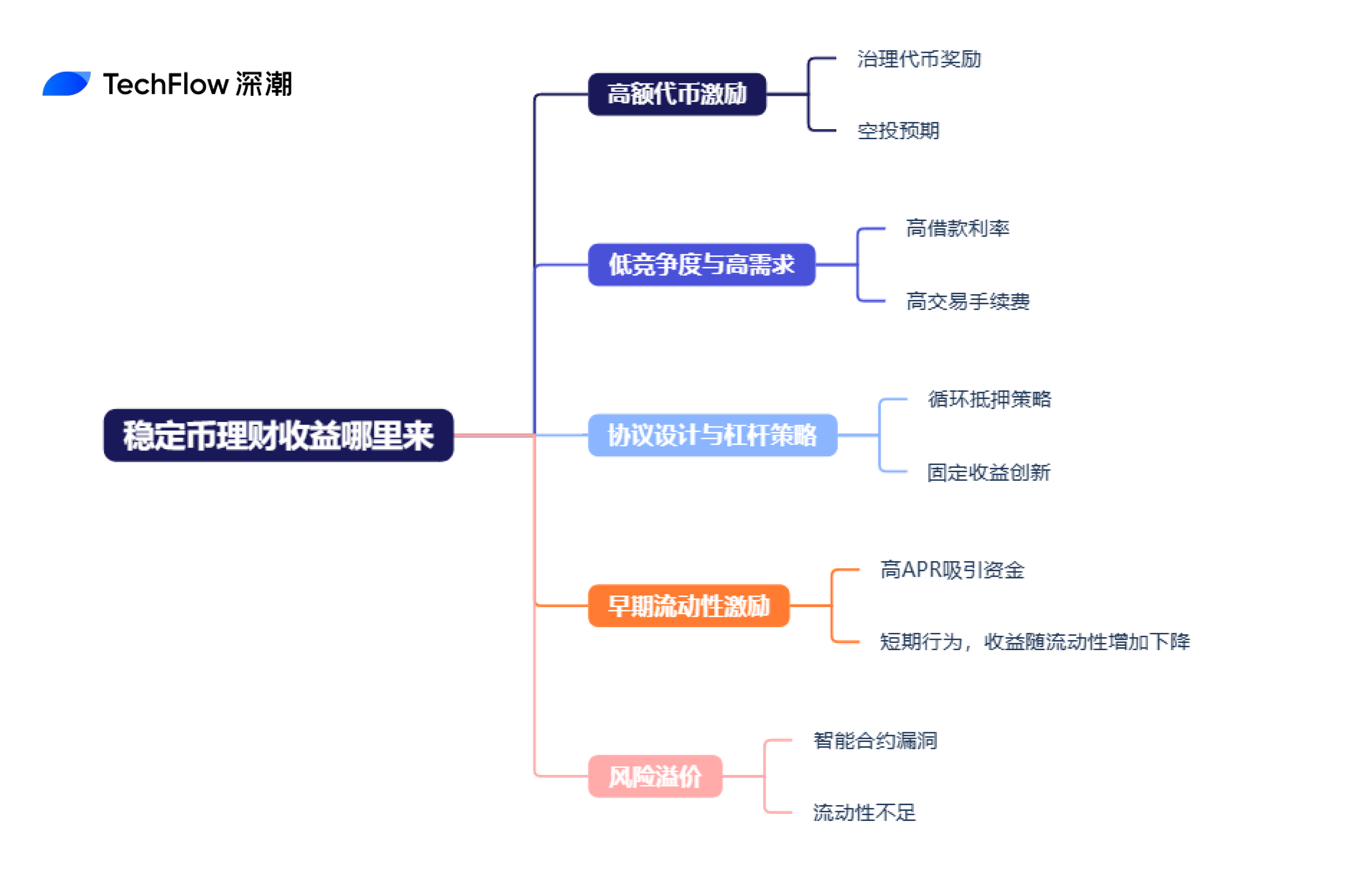
5. Risk Premium
"The gift that fate gives you has already been secretly marked with a price."
Although the above design can significantly increase profits, it is actually a compensation for the following risks:
Smart contract vulnerabilities : The protocols of emerging chains may not be fully audited and may pose a risk of vulnerabilities.
Insufficient liquidity : Insufficient funds may cause users to face higher slippage when exiting or be unable to redeem assets smoothly.
Ecological uncertainty : There is great uncertainty in the future development of emerging chains, and the agreement may fail due to user loss or technical problems.
After understanding the principles of these financial management returns, let’s take a look at the stablecoin financial management pools with relatively high yields on the market.
Berachain
Berachain does not need much introduction. Here you only need to know the assets in it:
BGT : Soul-bound governance token, used for PoL rewards and governance.
HONEY : A native stablecoin pegged 1:1 to the US dollar, it can be synthetically minted from a variety of assets and serve as a stable payment and lending tool within the ecosystem.
BYUSD/USDC.e : Other stablecoins, such as USD-pegged stablecoins or Ethereum-wrapped USDC, are introduced through cross-chain bridging.
The two core DeFi protocols in the Berachain ecosystem - Infrared Finance and Stride Zone - currently have liquidity pools for stablecoins that can perform yield farming.
Infrared Finance
Infrared Finance is a key DeFi protocol in the Berachain ecosystem, powered by Binance Labs, focused on simplifying Proof of Liquidity (PoL) participation and helping users maximize returns through its “vaults” product.
Infrared has also built liquidity staking products (such as iBGT) to enhance user experience and drive Berachain ecosystem growth.
As of February 2025, Infrared has not issued its own token , but its liquidity pool has been deeply integrated with Berachain's BGT incentive mechanism.
Stable currency financial management mechanism
Coin pairs and pools : Infrared provides the following stablecoin liquidity pools (BGT-qualifying LPs):
HONEY/BYUSD : HONEY is the native stablecoin of Berachain, and BYUSD is another stablecoin on Berachain.
HONEY/USDC.e : USDC.e is a packaged version of USDC on Ethereum introduced to Berachain through cross-chain bridging.
How to operate : Users deposit HONEY, BYUSD or USDC.e into a designated pool through Infrared's DeFi interface to form a liquidity pair (LP Token) and earn transaction fees, PoL rewards (BGT) and potential HONEY rewards. Pool income can be compounded through @beefyfinance to further increase long-term returns.
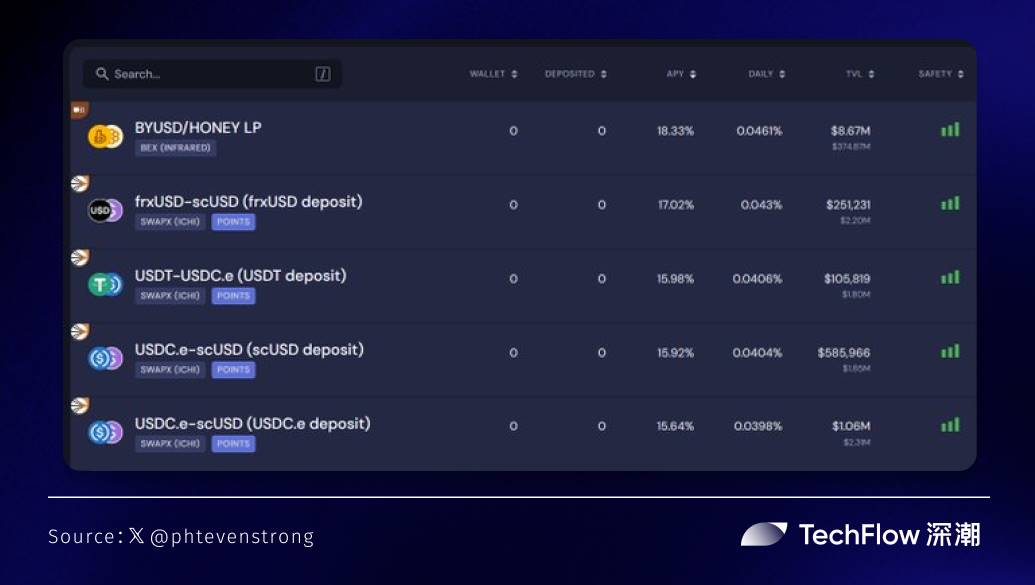
Current APY
HONEY/BYUSD : 18.45% APY
HONEY/USDC.e : 15% APY
Stride Zone
Stride Zone is a cross-chain liquid staking protocol that provides services to ecosystems such as Berachain, Cosmos, and Celestia. By staking Berachain's BGT as stBGT, Stride allows users to maintain asset liquidity while earning additional income. Stride supports stablecoin pools on Berachain to optimize the income flow of DeFi users.
Coin pairs and pools : Stride provides stablecoin liquidity pools similar to Infira (BGT-qualifying LPs):
HONEY/BYUSD : 22.52% APY
HONEY/USDC.e : 7.89% APY
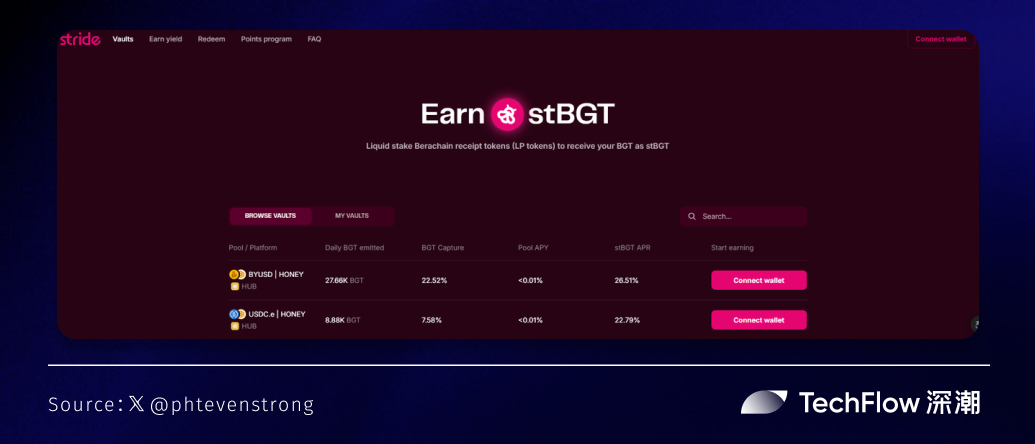
Dolomite
Dolomite (Dolomite.io) is a decentralized finance (DeFi) protocol that combines lending and decentralized exchange (DEX) functions to provide high-yield opportunities for Berachain users through leveraged cycles and automated strategies. Recently, due to the development of Boyco activities, Dolomite has seen a surge in demand for borrowed assets for pre-deposits, making the project's sUSDe strategy on Berachain perform outstandingly.
Note: Boyco is a recently launched on-chain activity by Berachain. Through Boyco, users can deposit assets in the liquidity market before the mainnet is launched. The total amount of pre-deposits has exceeded US$2.19 billion, which is considered to be one of the largest on-chain incentive activities in history.
Currency pairs and assets : Dolomite mainly conducts leverage operations based on a single stablecoin asset. It does not involve traditional liquidity pools, but optimizes returns through lending and recycling strategies:
sUSDe : A collateralized stablecoin issued by Ethena Labs, pegged 1:1 to the US dollar and introduced to Berachain through cross-chain bridges (such as Wormhole).
Borrowed assets : Users borrow GHO (Aave’s stablecoin) or USDC (introduced via USDC.e), with borrowing costs of 1.66% (GHO) and higher (USDC, the specific amount is not specified).
Operation method 1 :
Manual leverage loop (sUSDe Loop) : Users deposit sUSDe as collateral in the Dolomite interface, borrow GHO or USDC to loop sUSDe with 5x leverage (LLTV: 83%), earn 8.32% basic income of sUSDe, and achieve a maximum APY of 35% after deducting 1.66% borrowing cost.
For DeFi novices, you need to understand the following concepts:
LLTV (Loan-to-Value): Indicates the ratio between the loan amount (Loan) and the collateral value (Value). The higher the LLTV, the more the borrower can borrow, but the higher the liquidation risk.
An LLTV of 83% means that users can borrow 83% of the value of their sUSDe collateral into other assets (such as GHO or USDC). This is equivalent to 5x leverage (because 100% ÷ 83% ≈ 5), allowing users to amplify their returns, but also increasing liquidation risk. If the value of sUSDe drops or borrowing costs rise, an LLTV of more than 83% may trigger liquidation, causing part of the collateral to be sold to repay the debt.
For example : Assuming you have pledged $10,000 of sUSDe and the LLTV is 83%, you can borrow $8,300 (83% × $10,000) of GHO or USDC for revolving operations to earn additional income.
Operation method 2 :
Brategy strategy : a lazy version that selects a low-risk automated strategy (named Brategy), which does not require manual management and automatically provides approximately 21.95% APY.
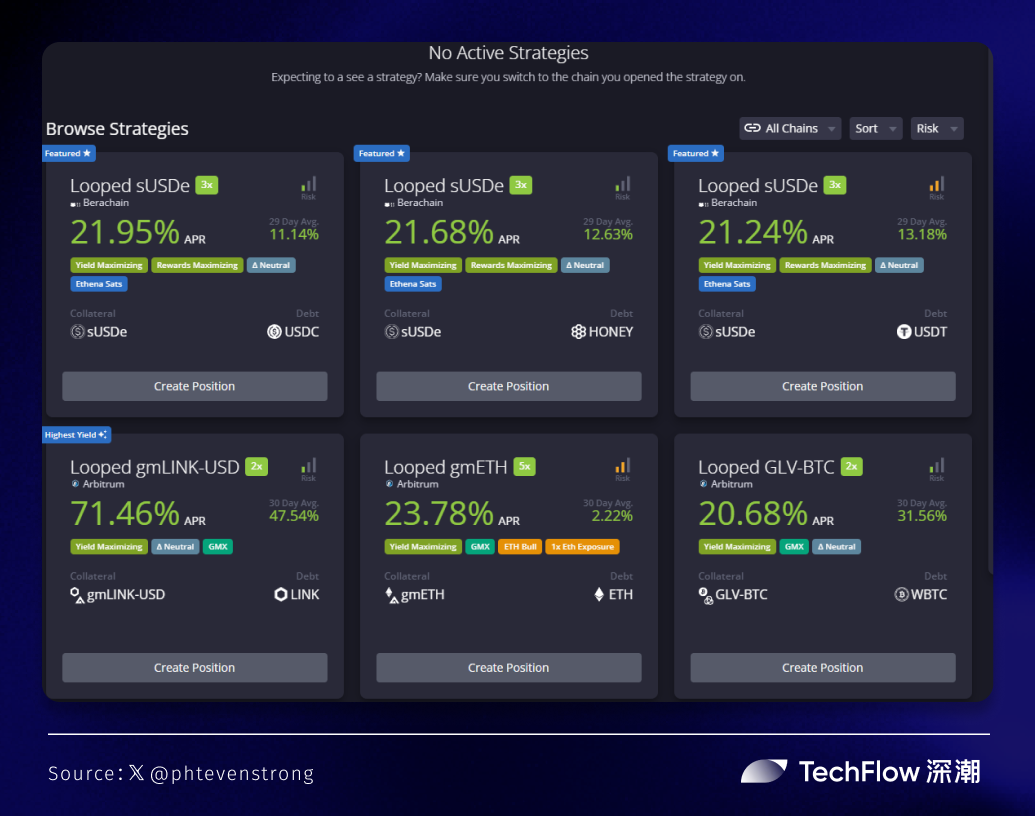
Goldilocks Money
Goldilocks Money is a DeFi protocol based on Berachain that imitates the design of Pendle and provides fixed interest rates and fixed-term income opportunities for stablecoins such as RUSD.
Currently, Goldilocks Money is attracting attention due to Berachain’s Proof of Liquidity (PoL) mechanism and the growth of ecosystem liquidity (exceeding US$2 billion by early 2025).
Coin pairs and assets : Goldilocks Money mainly provides fixed income based on a single stablecoin asset. It does not involve traditional liquidity pools, but optimizes income through fixed-term markets:
RUSD : A collateralized stablecoin issued by Reservoir, pegged 1:1 to the US dollar and introduced to Berachain through cross-chain bridging.
How to operate :
Users deposit RUSD on the Goldilocks Money platform, participate in the fixed-term (70-day) fixed-income market, and earn a preset 28% APR.
It is recommended to add RUSD liquidity through the liquidity pool on Kodiak (1% fee tier) to increase market liquidity and potential returns, but be aware of slippage risks.
Current APY :
RUSD fixed income : 28% APY (70-day fixed term)
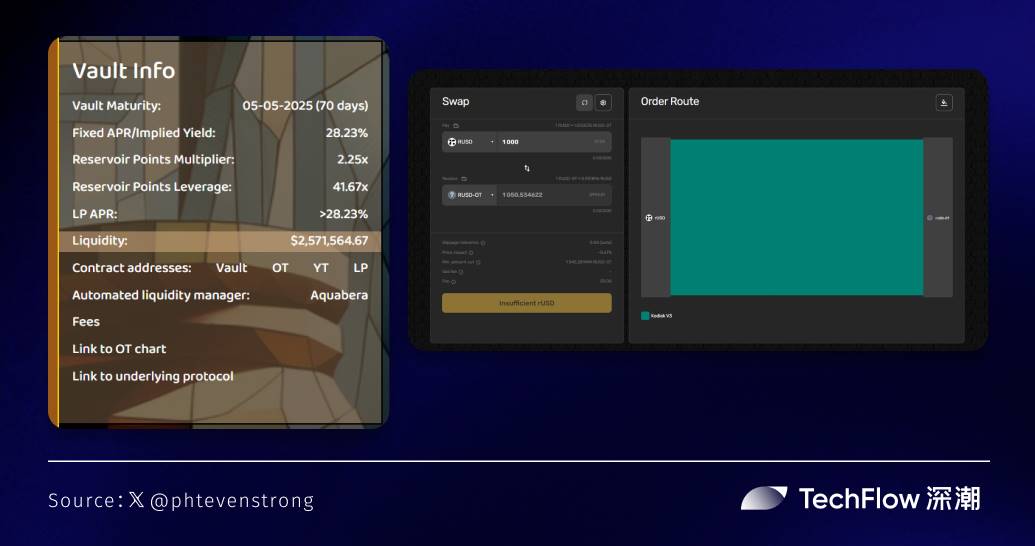
Sonic
That is the previous Fantom, L1 designed by DeFi master Andre Cronje, which has now been renamed.
Recent data shows that Sonic’s net capital inflow and TVL continue to increase, which to a certain extent also reflects that there must be opportunities for high mining returns in its ecosystem.
Euler Finance
Euler Finance is a decentralized lending protocol that provides high-yield stablecoin lending and recycling opportunities.
Background: In DeFi, lending means that users use assets (such as USDC.e) as collateral to borrow more funds (such as other stablecoins) from protocols (such as Euler Finance). Looping means reinvesting borrowed funds into the same asset or pool to amplify returns.
Coin pairs and assets : Euler Finance provides stablecoin lending and circulation on Sonic, which does not involve traditional liquidity pools, but optimizes returns through the lending market:
How it works : Users deposit USDC.e, stS or wS as collateral or lending assets through Euler Finance’s DeFi interface, conduct lending, looping or staking operations, and earn transaction fees, Sonic’s PoL rewards (if applicable) and additional incentives.
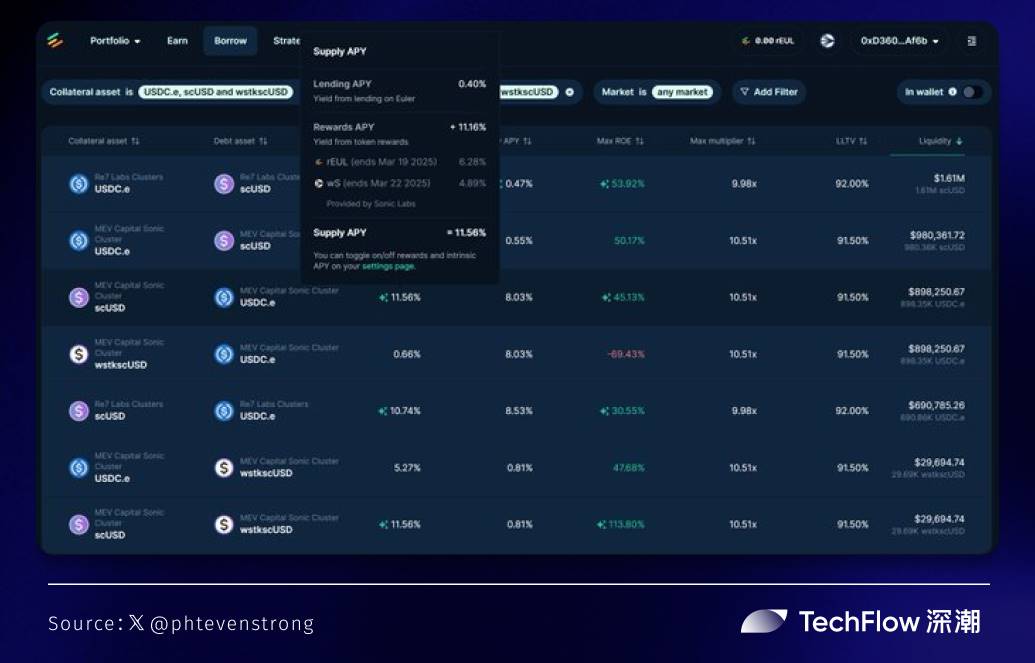
It is important to note that:
USDC.e : USDC on Ethereum introduces a packaged version of Sonic through cross-chain bridging, which is pegged to the US dollar at a 1:1 ratio and used as a stablecoin for lending or collateral.
stS : The staked token within the Sonic ecosystem, related to Sonic’s native token S, used to provide liquidity or earn additional income.
wS : Wrapped Sonic token of S, obtained through staking or liquidity provision, and distributed to users as part of the rewards.
rEUL : Euler Finance's "locked version" token (Restricted EUL) is a 1:1 mapping version of the governance token EUL in the Euler ecosystem. By locking EUL to generate rEUL, users can receive additional rewards (such as rEUL incentives on Sonic) and participate in Euler's governance. The rEUL incentive on Sonic provides users with a reward pool of up to $100,000 to attract DeFi users to participate.
wS points : reward tokens within the Sonic ecosystem. Users accumulate wS points by providing liquidity or lending operations, which can be used for future airdrops of Sonic's native token $S. For players who want to operate, pay attention to sorting the market by liquidity depth to ensure consistency of income (i.e. choose a pool with deeper liquidity to reduce slippage risk and maintain income stability).
Current income : USDC.e and other stablecoin lending/circulation, more than 50% APY
You want to ask why the returns are so high?
High returns come from the early incentives of the Sonic ecosystem (such as rEUL and wS rewards) and Berachain's Proof of Liquidity (PoL) mechanism, which attract users to provide liquidity. However, high returns are usually accompanied by high risks, such as insufficient liquidity or market volatility.
Shadow On Sonic
Shadow is positioned as Sonic's native centralized liquidity layer and exchange.
Similar to Solidly, it provides a high-yield stablecoin liquidity pool and introduces unique mechanisms such as $S airdrop points, Gems rewards, and x(3,3) incentive model.
Shadow’s native token has seen a good rise recently, and the project has also attracted attention in the DeFi ecosystem due to its high APR of mining income, the upcoming $S token airdrop, and Berachain’s PoL mechanism.
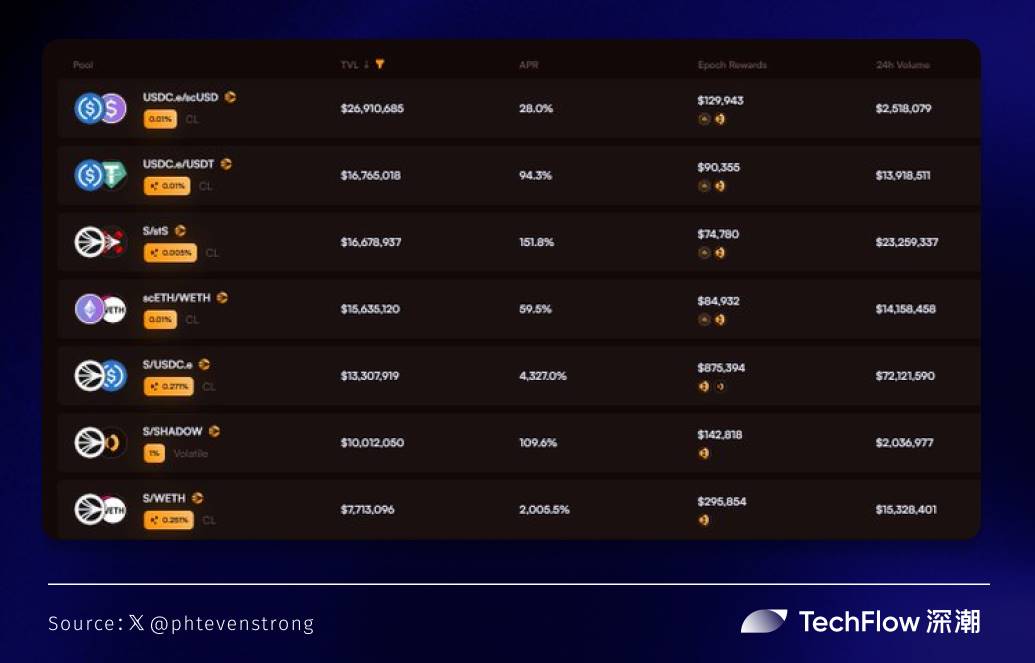
Coin pairs and pools : Shadow provides the following stablecoin liquidity pools (BGT-qualifying LPs), leveraging its centralized liquidity design to optimize capital efficiency and combining it with Sonic’s early incentives:
USDC.e/scUSD : USDC.e is a packaged version of USDC on Ethereum introduced into Sonic through cross-chain bridging. scUSD is a stablecoin within the ShadowOnSonic or Sonic ecosystem, pegged to the US dollar at a 1:1 ratio.
USDC.e/USDT : USDC.e and USDT (Tether’s stablecoin, introduced into Sonic through cross-chain bridging) form a liquidity pool.
How to operate : Users deposit USDC.e, scUSD or USDT into the designated pool through ShadowOnSonic’s DeFi interface to form a liquidity pair (LP Token) and earn transaction fees.
Current APY :
USDC.e/scUSD : 28% APY (50% immediately available, the rest unlocked via NFT)
USDC.e/USDT : 94% APY (50% immediately available, the rest unlocked via NFT)
Key concepts explained:
Concentrated Liquidity : Unlike traditional automated market makers (AMMs), Shadow allows liquidity providers (LPs) to concentrate funds within a specific price range (such as the narrow spread between USDC.e and USDT), improving capital efficiency and increasing trading depth and returns, but also increasing price volatility risks.
x(3,3) incentive model : Using the x(3,3) mechanism (improved version of the ve(3,3) model) of the Sonic ecosystem, xSHADOW is generated by locking $SHADOW tokens. Users can obtain protocol fees, voting rewards and additional incentives (such as $S points and Gems) to drive long-term liquidity provision and ecological development.
$S Points : Reward points within the Sonic ecosystem. Users accumulate $S points by providing liquidity, which can be used for future airdrops of Sonic's native token $S to increase long-term profit potential.
Gems Rewards : Additional rewards provided by ShadowOnSonic, similar to points. Accumulated Gems can be exchanged for more $S airdrop shares, but please note that some rewards (such as 50% of 94% APR) are unlocked through NFT, which may require waiting.
Ethereum
Old place, old ways, new benefits.
Contango
Contango (contango.xyz) is a high-yield stablecoin leveraged income strategy running on Ethereum.
Users deposit stablecoins (such as sUSDe, srUSD, or rUSD) into Contango as collateral or lending basis, and then borrow more funds through Morpho, Aave, and 0xFluid protocols to loop these assets and amplify returns.
These protocols provide deep liquidity pools and low borrowing costs. Contango circulates funds into these protocols through automated or manual operations, earning base returns and amplifying total returns through leverage.
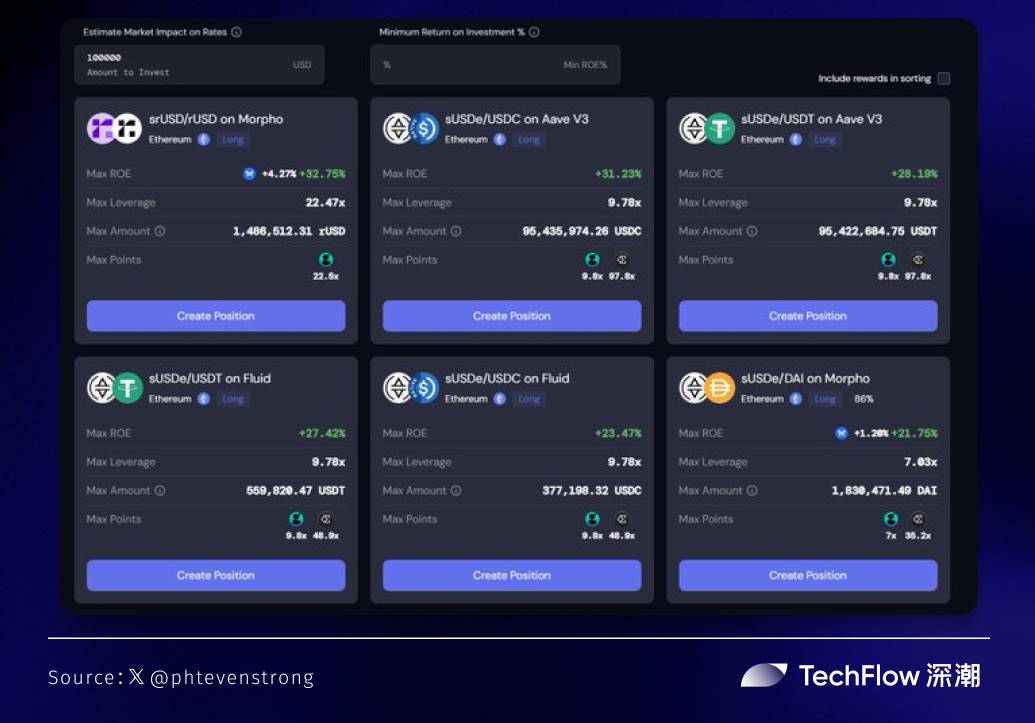
Currency pairs and assets :
srUSD/rUSD : srUSD (Savings rUSD) and rUSD (Reservoir USD) are stablecoins issued by the Reservoir Protocol, pegged to the US dollar at a 1:1 ratio. srUSD is the staking version of rUSD, which earns extra income by locking rUSD through the Reservoir protocol.
sUSDe/USDC : sUSDe is Ethena Labs' collateralized stablecoin, pegged 1:1 to the US dollar. USDC is the mainstream stablecoin issued by Circle and runs on Ethereum.
sUSDe/USDT : sUSDe and USDT (Tether’s stablecoin, running on Ethereum) form a leveraged pair.
How it works : Users deposit srUSD, sUSDe or USDT as collateral or lending assets through Contango’s DeFi interface, and perform leverage looping or staking operations through the above-mentioned Morpho, Aave and 0xFluid protocols to earn basic income and additional rewards.
TANGO Rewards : Points rewards within the Contango ecosystem. Users accumulate TANGO points by participating in leverage strategies, which can be used for future Contango tokens or ecosystem rewards to increase long-term profit potential.
In particular, the original author believes that these strategies require at least $100,000 in capital to avoid diluting returns due to small amounts of capital (the way big guys play).
Current APY :
srUSD/rUSD (Morpho Labs) : 36% APY (including TANGO rewards)
sUSDe/USDC (Aave) : 31% APY (including TANGO rewards)
sUSDe/USDT (0xFluid) : 27% APY (including TANGO rewards)
Why are the returns so high? The high returns come from the early incentives of the Ethereum ecosystem (such as TANGO rewards) and the optimization mechanisms of the underlying protocols (such as Morpho and Aave), which attract users to participate in leverage strategies. However, high returns are usually accompanied by high risks, such as liquidation risks, insufficient liquidity or market volatility.
Gearbox Protocol
A decentralized leveraged lending protocol running on Ethereum that allows users to borrow assets with up to 10x leverage for DeFi activities such as trading, liquidity mining, and more.
:Gearbox provides a leveraged looping strategy through a decentralized lending protocol on Ethereum to amplify the profit potential of stablecoins such as sUSDe. Users deposit stablecoins such as sUSDe into Gearbox as collateral or a lending basis, and then borrow more funds through Aave and Uniswap to cycle these assets and optimize returns.
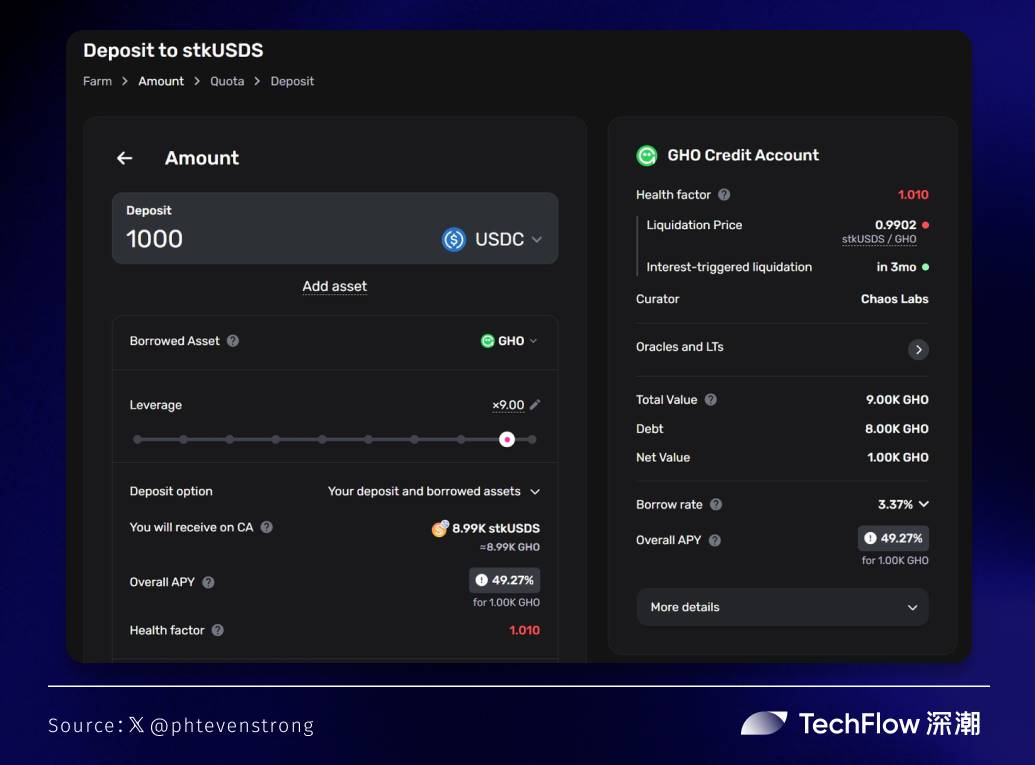
Coin pairs and assets : Gearbox offers the following stablecoin leveraged recycling strategies that do not involve traditional liquidity pools, but optimize returns through the lending market:
sUSDe : A pledged stablecoin issued by Ethena Labs, pegged to the US dollar at a 1:1 ratio. sUSDe is generated by locking USDe to earn basic returns (such as 8%-10% APY). Users can borrow GHO or USDC through Gearbox and recycle or invest in sUSDe to amplify their returns.
Borrowing assets : Users borrow GHO (Aave’s decentralized stablecoin) or USDC (Circle’s mainstream stablecoin, running on Ethereum) for leveraged circulation.
Current APY :
sUSDe leverage cycle (borrowing GHO) : about 49% APY (historical data, more than 30% for several consecutive weeks)
sUSDe leverage cycle (borrow USDC) : about 30% APY (historical data, more than 30% for several consecutive weeks)
Pendle
We are old friends, so I won’t introduce you to you in detail.
Pendle's fixed income market and composability have always attracted the attention of on-chain players.
Coin pairs and assets : Pendle offers the following stablecoin fixed income and liquidity strategies that do not involve traditional liquidity pools, but optimize returns through tokenized markets:
asUSDF : A collateralized stablecoin within the Aave ecosystem, generated by locking USDF, with a fixed income of 18% APY and a term of 92 days.
eUSDe : Ethena Labs' collateralized stablecoin, generated by locking USDe, with a fixed return of 18.3% APY and a term of 92 days.
Liquidity provision ( LP ) : Users provide asUSDF or eUSDe liquidity through Uniswap or Pendle's AMM, earning transaction fees (about 15% APY) and additional points (such as Syrup, Astherus, etc.)
How it works : Users deposit asUSDF or eUSDe as underlying assets through Pendle’s DeFi interface, participate in fixed-term markets or provide liquidity, and earn basic income and additional rewards.
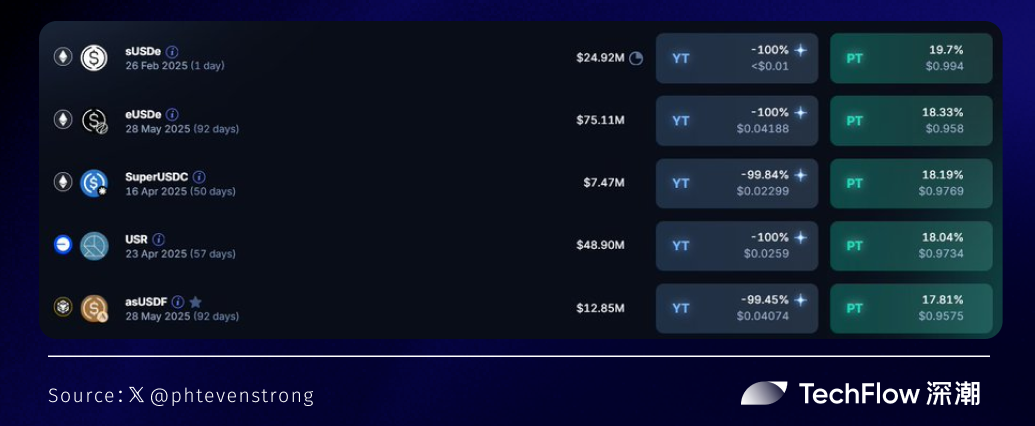
The basic concepts you may need to know are:
Fixed income market : Pendle allows users to tokenize stablecoins (such as eUSDe) into Principal Tokens (PT, representing principal) and Yield Tokens (YT, representing future returns). Users can lock eUSDe for 92 days and earn fixed returns (such as 18.3% APY), or trade YT for leveraged returns.
Through the compilation of this article and actual experience, we found that stablecoin financial management is a "safe haven" in the current market downturn, but it is not zero risk.
Investors are advised to start with small tests, pay attention to the audit status of the protocol, sustainability of returns, and liquidation risks, give priority to low-risk strategies on mature chains (such as Pendle's fixed income) or high-yield pools on emerging chains (such as ShadowOnSonic's 94% APY), and diversify investments to reduce risks.
For a more cautious consideration, you can choose the current stablecoin investment services provided by CEX. Due to space limitations, I have not listed them all. Their logic and operations are relatively more intuitive, and with the reputation of CEX as an endorsement, the risks are relatively controllable; but the returns do not seem to be as good as the projects listed above.
Finally, before the market gradually recovers, stablecoin investment may be a wise choice for steady progress, but do not ignore the "cost behind the benefits" - risks and returns always go hand in hand.








